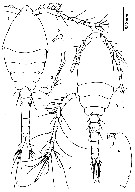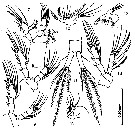|
|
 |
|
Cyclopoida ( Order ) |
|
|
|
Oithonidae ( Family ) |
|
|
|
Oithona ( Genus ) |
|
|
| |
Oithona oswaldocruzi Oliveira, 1945 (F,M) | |
| | | | | | | Syn.: | Oithona hebes : Gonzalez & Bowman, 1965 (part., figs.19, 20a); Bacon, 1971; Santos, 1973; Zoppi de Roa, 1974 (part., figs.10 A,B,D); Fonseca & Björnberg, 1976; Grau, 1978; Paranagua & al., 1986 (p.359);
Oithona oligohalina Fonseca & Björnberg, 1975 (1976) (p.127, figs.F,M, Rem.);
Oithona neotropica Herbst, 1967 (p.96, figs.F,M); Ferrari & Bowman, 1980 (p.15, figs.F, Rem.) | | | | Ref.: | | | Oliveira, 1945 a (p.460, Descr.F, figs.F); Rocha, 1986 (p.99, Redescr.F,M, figs.F,M, Rem.); Bradford-Grieve & al., 1999 (p.886, 966, figs.F,M); McKinnon, 2000 (p.108, Rem.) |  issued from : F.D. Ferrari & T.E. Bowman in Smiths. Contr. Zool., 1980, 312. [p.16, Fig.9]. As Oithona neotropica. Female (from Caribbean area): a, habitus (lateral right side); b, forehead (dorsal); c, urosome (lateral left side); d, Md; e, P4. Nota: Head broadly pointed dorsally, laterally distinctly quadrate. Rostrum absent. 4th pediger segment with hairs on posterior border. Caudal ramus length 3-times width. Endopodal segment 3 of P4 distal seta with flange on distal 1/2, proximal seta straight with flange on distal 1/2. Knob near genital opening with a curved spine and below it a smaller straight spine.
|
 issued from : V.L. Fonseca & T.K.S. Björnberg in Anais Acad. bras. Cienc., 1976, 47, Suppl. [p.128, Figs.1-6]. As Oithona oligohalina. Female (from Rio Taquari estuary, Brasil): 1, habitus (dorsal); 2, rostrum (lateral); 4, A1. Male: 3, A2; 5, habitus (dorsal); 6, cephalothorax (lateral).
|
 issued from : V.L. Fonseca & T.K.S. Björnberg in Anais Acad. bras. Cienc., 1976, 47, Suppl. [p.129, Figs.7-9]. As Oithona oligohalina. Female: 7-9, P1 to P3; 10, Md; 11, anal segment and caudal rami (dorsal); 12, A2; 13, Mx1; 14, P4.
|
 issued from : V.L. Fonseca & T.K.S. Björnberg in Anais Acad. bras. Cienc., 1976, 47, Suppl. [p.130]. As Oithona oligohalina (= O. oswaldocruzi. Table 1: Characters of 6 species of Oithona.
| | | | | Compl. Ref.: | | | Lopes, 1994 (tab.1); Eskinazi-Sant'Anna & Tundisi, 1996 (tab.1,2); Lopes & al., 1998 (p.195); Suarez-Morales & Gasca, 1998 a (p.112); Ara, 2001 b (p.121); 2004 (p.179, figs. 3, 4, 5); Choi & al., 2005 (p.710: Tab.III); Medellin-Mora & Navas S., 2010 (p.265, Tab. 2); Costa R.G. da & al;, 2011 (p.364, Table 1, seasonal occurrence); Pinheiro & al., 2011 (p.425, abundance vs season); Magris & al., 2011 (p.260, abundance, interannual variability); Miyashita & al., 2012 (p.1557, Table 2: occurrence); Garbosa da Costa & al., 2013 (p.756, Table 1, abundance vs tide); Ortega & al., 2014 (p.495, Table I, %); Fuentes-Reinés & Suarez-Morales, 2015 (p.369, Table 1, Rem. p.374); Ortega & al., 2017 (p.123, fig. 1, 6, table 2, abundance, %); Atique & al., 2017 (p.1, Table 1, fig.8, Rem.: p.11). | | | | NZ: | 3 | | |
|
Distribution map of Oithona oswaldocruzi by geographical zones
|
| | | | Loc: | | | Brazil (Paranagua Bay, Cananeia Lagoon, Mucuri estuary, Guarau estuary, Paranagua estuary, Rio de Janeiro, estuary do Pina, Ajuruteua Beach, Caeté Estuary, Amazon estuary), Venezuela, Caribbean Colombia (Tayrona, Laguna Navio Quebrado), Honduras (estuaries, laguna, coastal), Salvador, Ecuador, Guayaquil, G. of Mexico | | | | N: | 22 | | | | Lg.: | | | (765) F: 0,71-0,51; M: 0,65-0,46; (780) F: 0,71-0,53; M: 0,65-0,46; {F: 0,51-0,71; M: 0,46-0,65} | | | | Rem.: | Observed in ballasts of ships in San Francisco.
See in Oithona robertsoni Table 1 from McKinnon (2000, p.108).
After Fuentes-Reinés & Suarez-Morales, the specimens in the Laguna Navio Quebrado, were collected at a salinity of 28 p.1000. For Oliveira (1947) the species has been reported with salinities ranging from 0 to 33.7 p.1000. | | | Last update : 12/02/2021 | |
|
|
 Any use of this site for a publication will be mentioned with the following reference : Any use of this site for a publication will be mentioned with the following reference :
Razouls C., Desreumaux N., Kouwenberg J. and de Bovée F., 2005-2025. - Biodiversity of Marine Planktonic Copepods (morphology, geographical distribution and biological data). Sorbonne University, CNRS. Available at http://copepodes.obs-banyuls.fr/en [Accessed July 03, 2025] © copyright 2005-2025 Sorbonne University, CNRS
|
|
 |
 |







